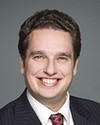The remaining two incidents, as alluded to by Mr. Christopherson, begin to get a little further away from the problems that members experience currently because we're going back now 20 years and, in one case, closer to 30 years, but nonetheless, there may be information that is of some use.
The next incident, the second last incident, involved a strike by the Public Service Alliance of Canada. That question was sent to PROC to study. I do not know how many meetings were held on it, but I do have a copy of the report. These are not available online because it was back in 1999. I went to 125 Sparks Street and printed off a copy from a book. As for the groups of witnesses, there were the members who raised the questions of privilege, Mr. Reynolds and Mr. Pankiw. There was as a second group, the general legal counsel of the House of Commons and Mr. Joseph Maingot, former law clerk and parliamentary counsel. The representatives from the Public Service Alliance of Canada and the Sergeant-at-Arms also appeared as well as a fourth grouping of witnesses.
As a summary of the incident, I'll try to make it quick. It was kind of a quirky incident. There was an ongoing labour dispute between PSAC and their employer, the Government of Canada. As part of this dispute, early February 17, 1999, members of PSAC set up picket lines at strategic locations on Parliament Hill and the Wellington Building, which, I guess, was open then, and then closed, and now reopened.
During the course of its study, the committee was told that the strategy was to slow down vehicle traffic onto the Hill but allow unimpeded movement of pedestrians. At the Wellington Building, the intention was to prevent employees and members of the public from entering. As members were required to be given access to Parliament Hill, security personnel were positioned in order to help identify members and to allow them to pass unimpeded. Nonetheless, the picket lines resulted in some difficulties for some members in accessing Parliament Hill and their offices.
On that day, the Speaker ruled that these allegations constituted a prima facie case, and the matter was referred to PROC. The committee reported to the House on April 17, 1999. With respect to the matter of contempt, the committee concluded that there was no deliberate intention to contravene parliamentary privilege in this case, that any contempt that occurred was technical and unintended, and that this was not an appropriate case for sanctions.
The committee nonetheless suggested the following preventative measures: that there be greater communication and coordination among the different police and security services responsible for security in and around the Hill; and that the Parliament of Canada Act be amended to extend the definition of Parliament Hill so that all buildings where members have their offices be included in that definition. The committee also suggested that a general level of awareness be raised about security issues and members' access to Parliament Hill. No further action was taken.
Last but not least, to keep it quick, the GST protest of October 30, 1989 was, again, a fairly unusual situation. The question of privilege was referred to PROC. There was no report, and as far as I could tell, having gone through the books in the library at 125 Sparks Street, there was no meeting even held on the matter. At the time, in case you're curious, the meetings in October 1989 were focusing on an order of reference from the House to study all aspects of radio and television broadcasting in the House and its committees.
In December 1989—so even when that study concluded, they did not pick up this study—they embarked on a study of the rights, immunities, and privileges of the members of the House of Commons that actually did not focus on this. The first meetings in 1990 were on the topic of parliamentary procedure in committees.
I could not find any evidence about the incident from procedure and House affairs. What happened that day, October 30, was a large demonstration. Apparently there were thousands of protestors in attendance on the Hill. Apparently hundreds of cab drivers were attempting to have a procession that would go onto Parliament Hill, do a loop, and come back down. They were prevented from accessing Parliament Hill by the RCMP.
Certain members, including the member who rose on the question of privilege, Mr. Gray, were present at the protest and saw that the cab drivers were not being permitted to enter onto the Hill, so they entered into the cabs and asked the cab drivers to drive them onto Parliament Hill. The RCMP still did not lift the roadblock, so someone went and fetched the Sergeant-at-Arms in the House, and the Sergeant-at-Arms came down to the roadblock. They had a negotiation with the sergeant of the RCMP in charge, and it was agreed that 30 cabs with members in them would be allowed to proceed. However, the cab drivers said that, if they all didn't get to go, none of them would go. The members got out of the cabs and walked. Eventually, apparently, the cabs were allowed to go up onto the Hill, and corollary to that, apparently a member who was arriving on the Hill in a cab outside of the process was prevented from entering onto the Hill, although the cab had no business with this other procession.





